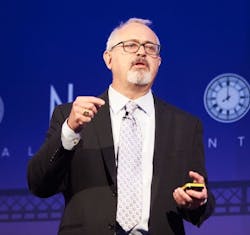Editor's note: our article by Tom Casey, Jr. describes how HVACR contractors can modify their marketing plans. Here's a companion piece, for the distribution professional.
For many wholesale distributors, marketing can be confusing. They don’t have a cohesive plan or how much to spend — or understand how different departments contribute to a campaign.
“Marketing has a huge attribution and budget problem in the distribution industry,” explains Ian Heller, founder of Distribution Strategy Group with 30 years of industry experience. “Some distributors don't know how to measure marketing, evaluate whether it's working and how much they should spend on it. If I don't know what I'm getting, I can't possibly know what to spend.
“The fundamental problem that some distributors make with marketing is they think about attribution in terms of sales growth generated by the marketing effort directly. However, they don't know the return on marketing because they aren’t measuring it; so, if they have to cut the budget, the marketing department goes first.”
Another problem, he adds, is that some distributor marketing departments are too focused on the company’s brand, generating branding guidelines that are not useful. The “brand cops” tend to treat these guidelines as written in stone when they should be flexible depending on the marketing idea. This is especially true when“Worst-case scenario is a sales rep comes up with a great idea for a promotion and gets a nasty email from somebody because he violated the brand guidelines,” Heller says. “Then they get obsessed with stuff such as likes on Facebook and Twitter mentions or LinkedIn posts; however, nobody believes any of that adds actual revenue. It's not that important. I know some very good distribution marketers, but that worst-case scenario is not uncommon.”
Marketing must work with counterparts in finance, product management, sales and operations to determine strategic goals the company wants to meet to produce significant sales and profit growth.
For a marketing campaign to be successful, the marketing department needs help from other parts of the organization.
“No marketing department works alone unless you are an absolutely pure single channel online marketer, which is almost no distributor today,” he notes. “Marketing's job is to create an effective marketing company.” He adds that to do this, marketing must work with counterparts in finance, product management, sales and operations to determine strategic goals the company wants to meet to produce significant sales and profit growth.
Heller prescribes an approach he learned years ago to achieve those goals — marketing by objective.
“Marketing needs to own the customer life cycle — customer acquisition, customer retention and growth of existing accounts — which, in most companies, no one owns,” he explains. “You want more new customers, you want to lose fewer customers, and you want the customers you have to grow faster.”
The first objective would be to retain customers — or prevent defection, as Heller explains it. This includes looking at those customers who statistically should have bought from you after a certain period but didn’t. If last year you lost 100 customers but are committed to only losing 80 this year, the marketing department can make an effort to call those customers who didn’t buy from you when they should have.
Set a measurable goal of how many new customers you want to attain this year. To reach this goal, you’ll send out more offers, do more prospecting.
New customers are the second objective; make sure to set a measurable goal of how many new customers you want to attain this year. To reach this goal, you’ll send out more offers, do more prospecting.
And the third objective is to get a certain number of existing customers to buy one more time a year.
Buying Psychology
“We've never even tried to stop losing customers before in a formal way,” Heller notes. “My Golden Rule of Marketing states that the more frequently you put relevant offers in front of targeted customers, the more frequently they'll buy from you.”
He cites a decades-old study by management consulting firm Bain & Co. about the psychology of buying.
“When people need something, an image of it pops into their head and it's not anything voluntary,” he explains. “The next thing they do is think about where the most likely places they might buy that item. ‘Where have I seen it for sale?’ And you can associate your company with the products and brands your customers want to buy. And you do that by constantly reminding them of what you sell.”
The biggest mistake marketers and distributors make, he says, is they assume their customers know every product type in their warehouses.
Associate your distribution company with the products and brands your customers want to buy. And you do that by constantly reminding them of what you sell.
“Ask anyone who's walked through warehouses or branches with customers regularly. They can recall when a customer pointed at a product line that they've been carrying for 30 years and asked, ‘Oh, when did you start carrying Honda generators?’ ‘Oh, we’ve been selling those since 1990. You didn't know that?’” Heller notes. “Customers don't know what you sell. When they need something, their synapses are not connecting that need with your company.”
Putting relevant offers in front of customers can be accomplished through direct mail pieces, email blasts, and merchandising on your website and at the counter.
“Take everything you can out of the back of your branch and put it in the merchandising area at the front of the branch because you want to constantly refresh your customer's memories of the connections between brands and products they need and your company,” he says. “Those connections decay and get replaced by other marketers. I'm not trying to measure marketing's direct contribution to any specific program. I'm trying to get marketing to focus on changing customer behavior.”
Measuring Over Time
You can measure how these objectives influence a distributor's revenue intake and profit margin within that year — but what about over five years?
“The results are asymmetric, and by that I mean that if a customer leaves, it can only go to zero; it can't become a negative sales company,” Heller explains. “However, if that company stays, it tends to grow, which means you get this compounding effect from retention over time. Small changes in customer lifecycle performance by affecting purchase frequency and the average order value can make your business a third bigger in sales and profits in five years.
“I've modeled this repeatedly with distributors and they are very surprised at the results.”
The marketing department can take those measurable results to determine a dollar value for sales and income. Management can use those numbers to decide what the marketing budget will be.
Be an Advocate
“You've got to do good marketing,” Heller notes. “You’ve got to do good promotions, good campaigns, but marketing also has to go and become an advocate to the rest of the company about the importance of meeting those goals.”
This may mean investing in software for the customer service reps that suggests related items on each order. Or it could mean instructing the counter sales staff to discontinue house account orders because the marketing department has no information on that customer for follow-up.
And it could mean engaging the sales staff with an easy task while they are out, such as photographing any contractor truck they don’t recognize as a customer and texting it to the marketing department.
“Your marketing department is creating a marketing company and focusing on customer life cycle, not trying to claim credit for promotions or do pointless stuff like focusing on branding,” he says.
To ensure success, it’s important to celebrate those who add value to customers — sales, customer service, operations, and people who pick, pack, and ship orders.
“Most of them are passionate about helping customers,” Heller states. “You realize they're at the top of the pyramid, not at the bottom. And everyone else is there to support them.”
Kelly Faloon is a contributing writer to Contracting Business magazine and principal of Faloon Editorial Services. The former editor of Plumbing & Mechanical magazine, she has more than 30 years of experience in B2B publishing, with more than 20 of those years in the plumbing and heating industry. Faloon is a journalism graduate of Michigan State University. You can reach her at [email protected].
About the Author

Kelly L. Faloon
Freelance Writer/Editor
Kelly L. Faloon is a contributing editor and writer to Contracting Business magazine, Contractor and HPAC Engineering. The former editor of Plumbing & Mechanical magazine, Faloon has more than 20 years experience in the plumbing and heating industry. She started a freelance writing and editing business in 2017, where she has a varied clientele.
Faloon spent 3 1/2 years at Supply House Times before joining the Plumbing & Mechanical staff in 2001. Previously, she spent nearly 10 years at CCH/Wolters Kluwer, a publishing firm specializing in business and tax law, where she wore many hats — proofreader, writer/editor for a daily tax publication, and Internal Revenue Code editor.
A native of Michigan’s northern Lower Peninsula, Faloon is a journalism graduate of Michigan State University. You can reach her at [email protected].

